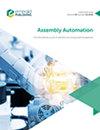Sensorless localization of a minimally-actuated robotic system for automated pallet de-strapping
IF 1.7
4区 计算机科学
Q3 AUTOMATION & CONTROL SYSTEMS
引用次数: 0
Abstract
Purpose The purpose of this paper is to detail the design and prototyping of a smart automation solution for de-strapping plastic bonding straps on shipping pallets, which are loaded with multiple containers secured by a top-cover as they move on a conveyor belt. Design/methodology/approach The adopted design methodology to have the system perform its function entails using the least number of sensors and actuators to arrive at an economic solution from a system design viewpoint. Two prototypes of the robotic structure are designed and built, one in a research laboratory and another in an industrial plant, to perform localized cutting and grabbing of the plastic straps, with the help of a custom-designed passive localizing structure. The proposed structure is engineered to locate the plastic straps using one degree of freedom (DOF) only. An additional strap removal mechanism is designed to collect the straps and prevent them from interfering with the conveyor. Findings The functionality of the system is validated by performing full-process tests on the developed prototypes in a laboratory setting and under real-life operating conditions at BMW Group facilities. Testing showed that the proposed localization system meets the specified requirements and can be generalized and adapted to other industrial processes with similar requirements. Practical implications The proposed automated system for de-strapping pallets can be deployed in assembly or manufacturing facilities that receive parts in standard shipping pallets that are used worldwide. Originality/value To the best of the authors’ knowledge, this is the first mechanically smart system that is used for the automated removal of straps from shipping pallets used in assembly facilities. The two main novelties of the proposed design are the robustness of the strap localization without the need for computer vision and a large number of DOF, and the critical placement and choice of the cutting and gripping tools to minimize the number of needed actuators.用于自动托盘捆扎的最小驱动机器人系统的无传感器定位
本文的目的是详细介绍一种智能自动化解决方案的设计和原型设计,该解决方案用于在运输托盘上拆除塑料粘合带,这些托盘上装载着多个集装箱,当它们在传送带上移动时,由顶盖固定。设计/方法/方法采用的设计方法使系统执行其功能,需要使用最少数量的传感器和执行器,从而从系统设计的角度获得经济的解决方案。设计并制造了两个机器人结构原型,一个在研究实验室,另一个在工业工厂,在定制设计的被动定位结构的帮助下,对塑料带进行局部切割和抓取。所提出的结构被设计为仅使用一个自由度(DOF)来定位塑料绑带。一个额外的皮带去除机构被设计来收集皮带和防止它们干扰输送机。通过在实验室环境和宝马集团工厂的实际操作条件下对开发的原型进行全流程测试,验证了系统的功能。试验表明,所提出的定位系统满足了规定的要求,并且可以推广和适应具有类似要求的其他工业过程。实际意义提议的自动化拆包托盘系统可以部署在装配或制造设施中,这些设施接收世界范围内使用的标准运输托盘中的部件。原创性/价值据作者所知,这是第一个机械智能系统,用于自动移除装配设施中使用的运输托盘上的绑带。该设计的两个主要新颖之处是,在不需要计算机视觉和大量自由度的情况下,皮带定位的鲁棒性,以及切割和夹持工具的关键位置和选择,以尽量减少所需执行器的数量。
本文章由计算机程序翻译,如有差异,请以英文原文为准。
求助全文
约1分钟内获得全文
求助全文
来源期刊

Assembly Automation
工程技术-工程:制造
CiteScore
4.30
自引率
14.30%
发文量
51
审稿时长
3.3 months
期刊介绍:
Assembly Automation publishes peer reviewed research articles, technology reviews and specially commissioned case studies. Each issue includes high quality content covering all aspects of assembly technology and automation, and reflecting the most interesting and strategically important research and development activities from around the world. Because of this, readers can stay at the very forefront of industry developments.
All research articles undergo rigorous double-blind peer review, and the journal’s policy of not publishing work that has only been tested in simulation means that only the very best and most practical research articles are included. This ensures that the material that is published has real relevance and value for commercial manufacturing and research organizations.
 求助内容:
求助内容: 应助结果提醒方式:
应助结果提醒方式:


